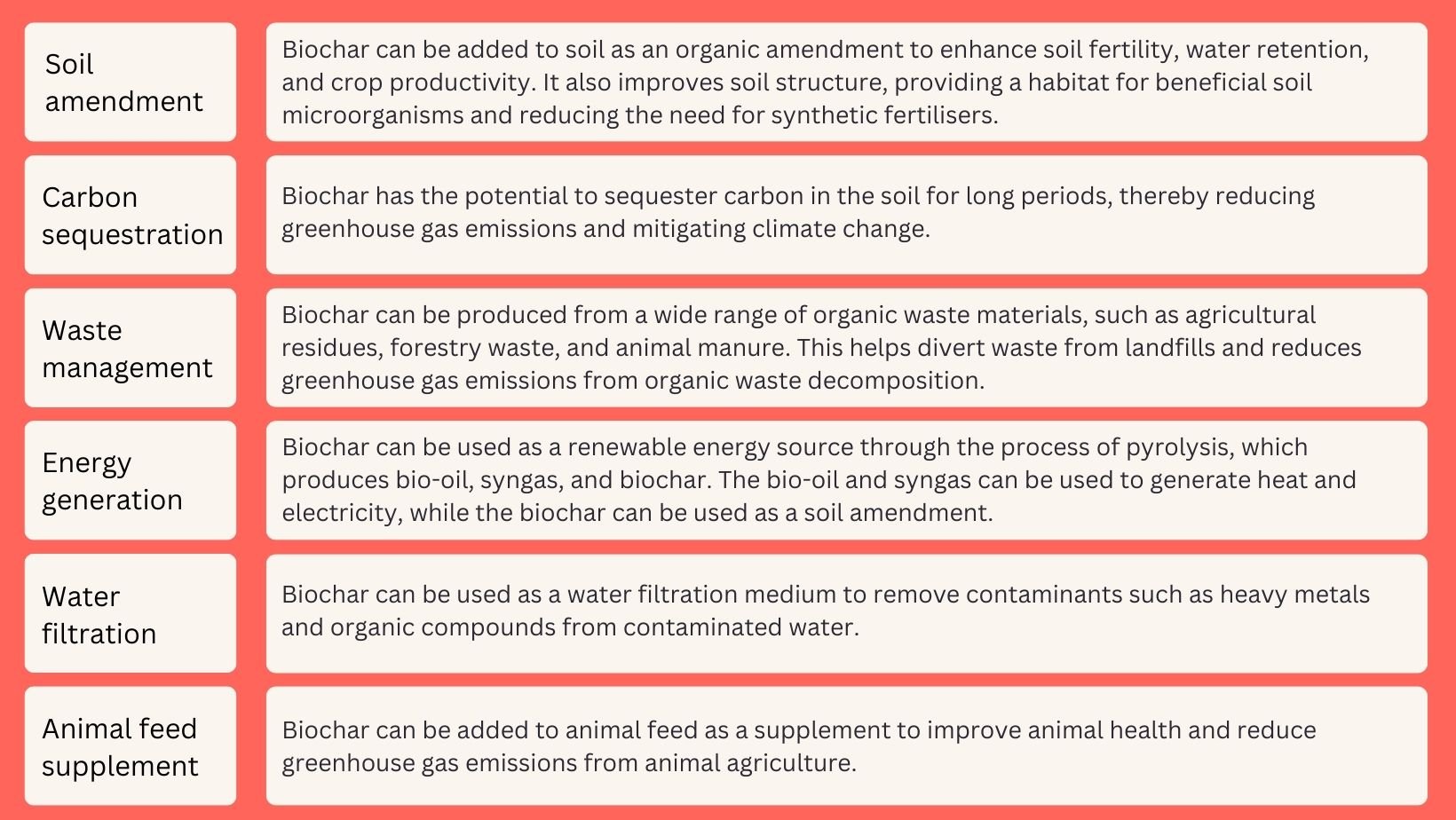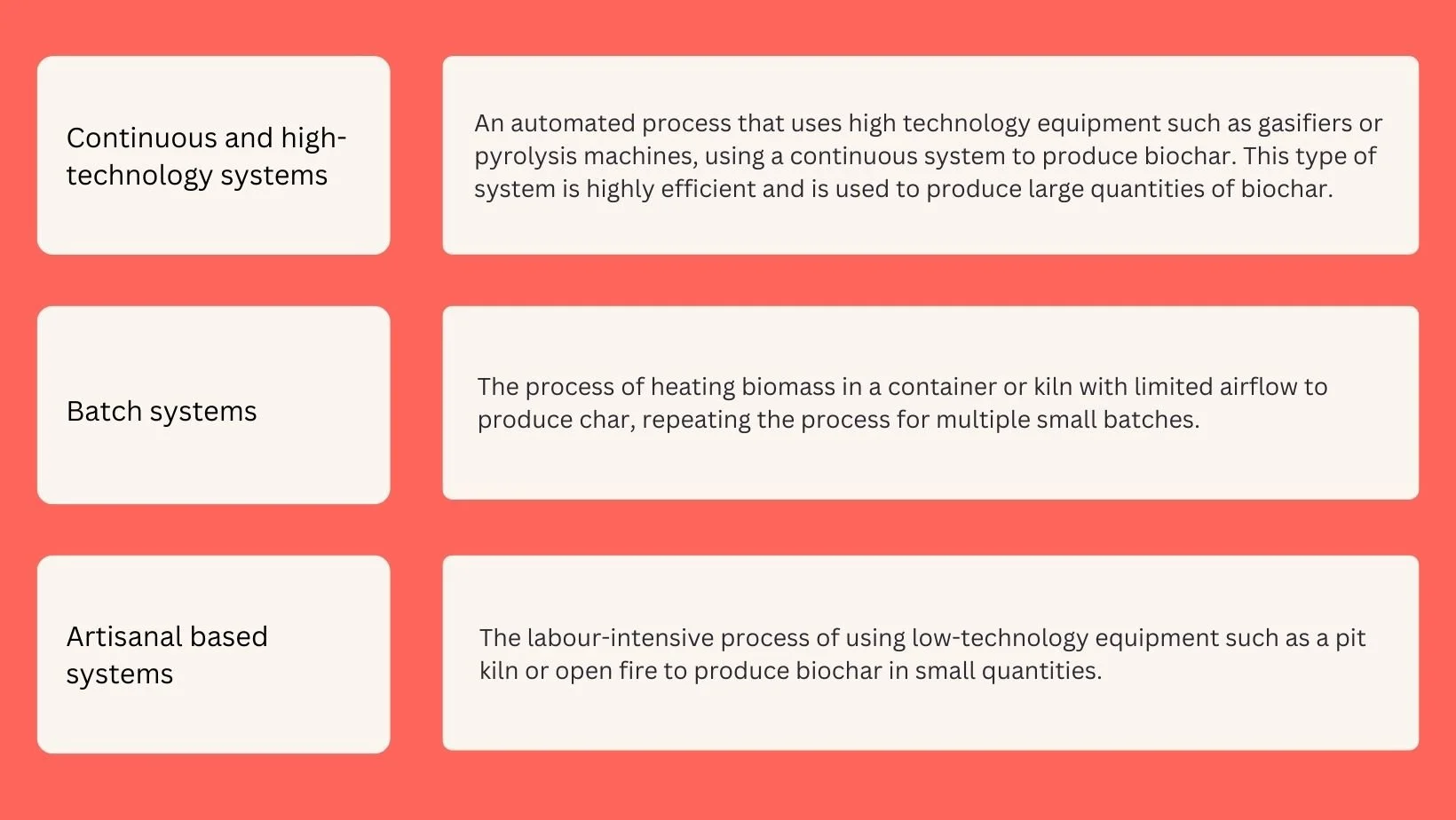Feel the burn: exploring biochar’s climate benefits
In this series of blogs, Kita offers an insight to the variety of carbon removal and emissions avoidance project types contributing credits to the VCM. We describe the carbon removal technique, relate the ways in which the methodology operates within the carbon market, outline the potential risks involved and highlight the ways in which insurance can reduce the risk profile and contribute to progress for the approach in question.
Our aim is to demystify these methodologies and clarify their position within the VCM. We hope that greater transparency and understanding of carbon removal technologies helps to increase confidence and drive investment towards these projects.
In this post we consider biochar.
What is Biochar? What does it do?
Essentially a form of carbonised biomass, biochar is a type of charcoal that is produced by heating organic biomass, such as wood, crop residues, or manure, in the absence of oxygen through a process called pyrolysis. Pyrolysis involves heating the biomass to a high temperature (typically between 350-700°C) in a container with limited air supply, which causes the biomass to undergo a chemical transformation and break down into a solid, carbon-rich material.
While biochar has a range of benefits, some of the primary uses of biochar and its co-products are listed below:
Recently, a research team at Washington State University have created a new carbon-negative concrete product that highlights the wonders of biochar. The product contains biochar, cement, and concrete wastewater. During its creation, the concrete absorbs carbon dioxide from the atmosphere and can lock CO2 emissions for about 30 years when used for pavements and for approximately 75 years when used in bridge construction.
Different feedstocks and pyrolysis temperatures can yield biochar with different properties and characteristics. Based on these properties, different types of biochar have varying applications. This is dependent on the type of feedstock used, the pyrolysis temperature and duration, as well as any post-processing treatments applied. For example, biochar produced from wood at high temperatures tends to have a higher carbon content, greater porosity, and a higher surface area than biochar produced from lower temperatures. Biochar produced from agricultural residues, such as corn stover or wheat straw, tends to have a lower carbon content and a higher ash content compared to wood-based biochar. Furthermore, the pyrolysis temperature can also affect the chemical composition of the biochar, as it influences the amount of volatile gases and organic compounds that are released during the pyrolysis process. Higher temperatures can lead to a greater loss of volatile gases and organic compounds, resulting in a more stable biochar with higher carbon content.
While there are various technology types to produce biochar, they can broadly be classified into three categories: continuous and high-technology systems, batch systems and artisanal-based systems. Refer below for brief descriptions of these technologies:
How do biochar projects relate to the carbon markets?
The first ever carbon removal crediting methodology for biochar was brought into the market in 2019 by Puro Earth. Following Puro, Verra published a Verified Carbon Standard (VCS) biochar methodology in 2022. Additionally, the European Biochar Certificate (EBC), a voluntary standard, was developed in 2012 to ensure the quality and safety of biochar products in Europe. These methodologies ensure that users of biochar-based credits benefit from transparent and verifiable monitoring and quality assurance.
Biochar is a powerful tool: a carbon-rich product made from biomass that helps the earth by increasing its physical, chemical, and biological properties. As a carbon-rich material produced through the pyrolysis of biomass, biochar can lock carbon in a stable form for extended periods, thereby offering a unique pathway for carbon sequestration and emissions reduction. The revenue generated from the sale of biochar carbon credits provides financial incentives for biochar production and encourages the adoption of this climate-friendly technology. Through its participation in the carbon markets, biochar contributes to the overall goal of reducing greenhouse gas emissions and mitigating climate change.
The market size of the global biochar market was evaluated at USD 220.27 billion in 2022 and is expected to hit around USD 633.31 billion by 2032. While the science and technology of biochar production are still evolving, there is already a growing body of evidence supporting its effectiveness to contribute to building a more resilient and sustainable future.
Industry insights and experts
PYREG is a biochar pioneer that plays a significant role in the carbon markets by offering innovative pyrolysis technology for the production of biochar. Their advanced pyrolysis systems enable the efficient conversion of biomass into high-quality biochar while capturing valuable by-products like syngas and heat. By providing scalable and sustainable biochar production solutions, PYREG contributes to carbon sequestration and the generation of carbon credits. Their technology supports the development of biochar projects that can generate verified emissions reductions, which can then be traded in the carbon markets. With their expertise and technology, PYREG facilitates the integration of biochar into climate change mitigation strategies, helping to address global carbon emissions and promote sustainable land management practices.
GECA Environnement is an internationally-recognised consulting firm providing expert consultants in biochar and pyrolysis. A knowledgeable firm in the industry, they specialise in waste valorisation using thermal transformation systems, such as pyrolysis, torrefaction, and gasification. Founded in 2015, based on 25 years of R&D experience in environment, 15 of which were specifically on biochar and pyrolysis, their range of services include expert work project development of industrial symbiosis, strategic planning, evaluation/selection of technologies, grant redaction, biochar carbon credit generation and project management.
What are the specific risks in regard to biochar projects?
The methodologies identify several key risk factors that can affect the quality and environmental integrity of biochar projects. These risk factors include:
Additionality: This refers to the degree to which the biochar project is additional to what would have happened in the absence of the project.
Leakage: This refers to the degree to which the biochar project results in unintended emissions elsewhere, such as from changes in land use or management practices outside of the project area.
Permanence: This refers to the degree to which the carbon stored in the biochar product will remain sequestered over the long term. There is a risk that the carbon could be released back into the atmosphere due to natural or human-induced factors.
Baseline: This refers to the level of emissions that would have occurred in the absence of the biochar project. Accurately determining the baseline emissions is essential for measuring the carbon mitigation achieved by the project.
Quantification: This refers to the degree to which the carbon sequestration achieved by the project can be accurately measured and verified.
Perceived risks: This refers to any additional risks or uncertainties associated with the biochar project that could affect its environmental integrity or social acceptability, such as impacts on biodiversity or local livelihoods.
Addressing these key risk factors ensures that biochar projects deliver real and additional climate benefits while minimising unintended negative impacts.
Can insurance help manage these risks?
Insurance can help manage risks associated with biochar in multiple ways:
Unavoidable risks, like natural catastrophes, can have an impact on biochar if the project area lies in an area of elevated risk, leading to unexpected stops in production. Insurance can build resilience when unexpected occurrences strike.
Avoidable risks, like acts of fraud or negligence by project developers, or the insolvency of the project developer, can happen in carbon projects across multiple types. Insurance can protect buyers of carbon credits against these types of challenges impacting on their carbon purchases.
Carbon risks, like reassessments to baselines or changes/invalidation of carbon standards/methodologies are broader risks factors in the carbon markets that can impact biochar projects. Insurance can perform a comprehensive assessment of the project, including risk management and compliance with standards, providing financial protection and coverage against these risks.
Insurance can provide coverage against other risks specific to biochar projects such as those related to feedstocks used and technical risks in operating the production facility.
Conclusion
Due to its significant potential to durably store carbon, biochar has gained a great deal of attention and support in recent times. Biochar has the potential to sequester carbon from the atmosphere and store it in the soil for hundreds or even thousands of years, reducing carbon within the atmosphere and contributing towards the mitigation of climate change. In addition to its carbon sequestration benefits, biochar can improve soil fertility, water retention, and nutrient availability, making it a valuable tool for sustainable agriculture and land management.
Realising the full potential of biochar in climate change mitigation requires addressing challenges related to scalability, cost-effectiveness, and ensuring sustainable sourcing of biomass feedstock. Research and development efforts, coupled with supportive policies and incentives, are crucial for further unlocking the potential of biochar and facilitating its widespread adoption. Overall, biochar represents a valuable tool in the fight against climate change, offering a holistic approach that combines carbon sequestration, soil improvement, and sustainable agriculture.



